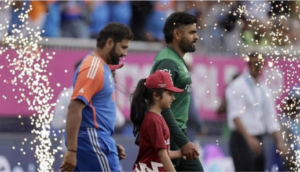
IPL 2025 vs. Champions Trophy : Cricket has evolved significantly over the past two decades, with franchise leagues like the Indian Premier League (IPL) revolutionizing player salaries. As the Champions Trophy 2025 approaches, comparisons between international and franchise cricket are inevitable. One of the biggest talking points is the financial disparity between the two. Why does international cricket, once the pinnacle of the sport, pay significantly less than leagues like the IPL? Let’s explore the reasons behind this shift.
Champions Trophy 2025 vs. IPL 2025 : Why International Cricket Pays Less

1. Revenue Model: Centralized vs. Decentralized
International cricket operates under a centralized revenue model where earnings from broadcasting rights, sponsorships, and ticket sales are controlled by national boards. Players receive a fixed salary based on contracts with their respective cricket boards, along with match fees and bonuses.
On the other hand, IPL franchises function under a decentralized model, where private ownership drives revenues. Each team negotiates its sponsorship deals, and the league generates massive broadcasting rights revenue, allowing franchises to pay hefty salaries to players. Unlike national boards, which distribute earnings among all players and invest in grassroots cricket, IPL franchises focus primarily on winning and maximizing their brand value.
2. Tournament Duration and Frequency
The Champions Trophy, like other ICC tournaments, is held once every four years, whereas the IPL is an annual event. The latter’s consistency ensures sustained revenue generation, making it easier for teams to commit high salaries to players.
Additionally, the IPL lasts for approximately two months, while international tournaments are often shorter. This condensed format allows franchises to attract big names for a limited period, compensating them handsomely without the long-term commitments that international boards have to consider.
3. Commercialization and Market Demand
Franchise cricket is designed for commercial success. The IPL, for instance, attracts massive global viewership, with sponsors and advertisers willing to invest millions. The high entertainment factor—featuring shorter matches, star players, and a city-based loyalty system—drives engagement.
International cricket, though prestigious, often struggles with dwindling viewership, especially in bilateral series. Except for marquee events like the Cricket World Cup or Ashes, the commercial appeal of international matches has declined, affecting player earnings.
4. Player Availability and Workload Management
International cricketers are bound by national duties, often playing year-round across formats. This workload means they cannot participate in multiple T20 leagues, reducing their earning potential compared to those who focus solely on franchise cricket.
In contrast, T20 specialists or retired international players maximize earnings by playing in multiple leagues like the IPL, BBL, PSL, and The Hundred. Their earnings often surpass those of centrally contracted players, leading to increased preference for franchise cricket among younger talents.
5. Brand Endorsements and Sponsorships
Playing in a high-profile league like the IPL boosts a player’s marketability, leading to lucrative endorsement deals. Franchises aggressively market their players, offering additional income streams beyond salaries.
International cricket, with its stringent regulations, limits commercial opportunities for players. Endorsement deals often require board approval, reducing flexibility and income potential compared to IPL stars, who have more autonomy.
6. Prize Money and Player Auctions
The IPL’s auction model is another major factor. Unlike international cricket, where players have fixed contracts, the IPL’s dynamic bidding system drives salaries higher each year. The demand-supply mechanism ensures that top players receive multi-million-dollar deals, whereas in international cricket, even the best players earn a fraction of these amounts through contracts and match fees.
ICC tournaments, including the Champions Trophy, offer prize money, but it is shared among the team rather than directly benefiting individual players. In contrast, IPL players have personal contracts that guarantee higher pay irrespective of their team’s performance.
7. Governing Bodies’ Approach
National cricket boards prioritize the sport’s long-term development over individual earnings. Funds are allocated to grassroots programs, infrastructure, and domestic leagues, ensuring sustainability. While this approach strengthens the sport, it limits the funds available for player salaries.
In contrast, IPL franchises operate as businesses aiming for short-term success, pushing player salaries to unprecedented levels. This business-driven model allows for higher payouts and better financial incentives for players.
8. Shift in Cricket’s Ecosystem
With T20 cricket gaining popularity, players are increasingly opting for franchise leagues over international commitments. Younger cricketers are making career decisions based on financial stability, with some even foregoing central contracts to become free agents in the T20 circuit.
If international cricket does not adapt its financial model, it may struggle to retain top talents, further widening the gap between national teams and franchise leagues.
Conclusion

The Champions Trophy 2025 will be a grand spectacle, showcasing the best international cricket has to offer. However, when it comes to financial rewards, the IPL 2025 will overshadow it. The franchise model, shorter format, commercial appeal, and player-centric contracts have created an ecosystem where leagues like the IPL pay significantly more than international cricket.
As cricket continues to evolve, national boards may need to rethink their financial structures to ensure international cricket remains attractive to players. Otherwise, the growing dominance of franchise leagues could redefine the future of the sport.






9p3s9e